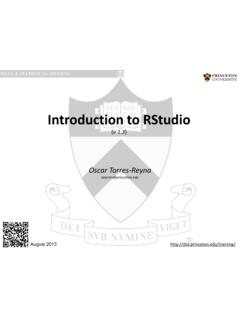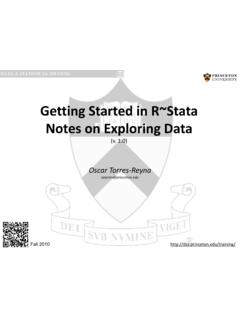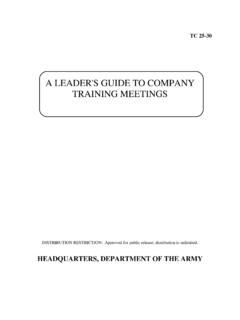Transcription of Panel Data Analysis Fixed and Random Effects using Stata …
1 Panel data Analysis Fixed and Random Effects using Stata (v. ) Oscar Torres-Reyna December 2007 PU/DSS/OTRI ntroPanel data (also known as longitudinal or cross-sectional time-series data ) is a dataset in which the behavior of entities are observed across entities could be states, companies, individuals, countries, data looks like thiscountryyearYX1X2 data allows you to control for variables you cannot observe or measure like cultural factors or difference in business practices across companies; or variables that change over time but not across entities ( national policies, federal regulations, international agreements, etc.)
2 This is, it accounts for individual Panel data you can include variables at different levels of Analysis ( students, schools, districts, states) suitable for multilevel or hierarchical drawbacks are data collection issues ( sampling design, coverage), non-response in the case of micro panels or cross-country dependency in the case of macro panels ( correlation between countries)Note: For a comprehensive list of advantages and disadvantages of Panel data see Baltagi, Econometric Analysis of Panel data (chapter 1).3PU/DSS/OTRI ntroIn this document we focus on two techniques use to analyze Panel data : Fixed Effects Random Effects 4PU/DSS/OTRS etting Panel data : xtsetThe Stata command to run Fixed / Random effecst is xtreg.
3 Before using xtregyou need to set Stata to handle Panel data by using the command xtset. type:xtset country year delta: 1 unit time variable: year, 1990 to 1999 Panel variable: country (strongly balanced). xtset country yearIn this case country represents the entities or panels (i) and year represents the time variable (t).The note (strongly balanced) refers to the fact that all countries have data for all years. If, for example, one country does not have data for one year then the data is unbalanced. Ideally you would want to have a balanced dataset but this is not always the case, however you can still run the : If you get the following error after using xtset:You need to convert country to numeric, type:encode country, gen(country1)Use country1 instead of country in the xtsetcommand 5varlist: country.
4 String variable not allowedPU/DSS/OTRE xploring Panel datause country yearxtline + + + + + + + + + + + +10199019952000199019952000199019952000 ABCDEFG yyearGraphs by countryPU/DSS/OTRE xploring Panel dataxtline y, + + + +1y199019921994199619982000yearABCDEFGPU /DSS/OTRFIXED- Effects MODEL(Covariance Model, Within Estimator, Individual Dummy Variable Model, Least Squares Dummy Variable Model)8 Fixed Effects Use Fixed - Effects (FE) whenever you are only interested in analyzing the impact of variables that vary over time. FE explore the relationship between predictor and outcome variables within an entity (country, person, company , etc.)
5 Each entity has its own individual characteristics that may or may not influence the predictor variables (for example, being a male or female could influence the opinion toward certain issue; or the political system of a particular country could have some effect on trade or GDP; or the business practices of a company may influence its stock price). When using FE we assume that something within the individual may impact or bias the predictor or outcome variables and we need to control for this. This is the rationale behind the assumption of the correlation between entity s error term and predictor variables. FE remove the effect of those time-invariant characteristics so we can assess the net effect of the predictors on the outcome variable.
6 Another important assumption of the FE model is that those time-invariant characteristics are unique to the individual and should not be correlated with other individual characteristics. Each entity is different therefore the entity s error term and the constant (which captures individual characteristics) should not be correlated with the others. If the error terms are correlated, then FE is no suitable since inferences may not be correct and you need to model that relationship (probably using Random - Effects ), this is the main rationale for the Hausman test (presented later on in this document). PU/DSS/OTR 9 PU/DSS/OTRF ixed effectsThe equation for the Fixed Effects model becomes:Yit= 1 Xit+ i+ uit [ ]Where i(i= ) is the unknown intercept for each entity (nentity-specific intercepts).
7 Yit is the dependent variable (DV) where i= entity and t= time. Xit represents one independent variable (IV), 1 is the coefficient for that IV, uit is the error term The key insight is that if the unobserved variable does not change over time, then any changes in the dependent variable must be due to influences other than these Fixed characteristics. (Stock and Watson, 2003, ). In the case of time-series cross-sectional data the interpretation of the beta coefficients would be ..for a given country, as Xvaries across time by one unit, Yincreases or decreases by units (Bartels, Brandom, Beyond Fixed Versus Random Effects : A framework for improving substantive and statistical Analysis of Panel , time-series cross-sectional, and multilevel data , Stony Brook University, working paper, 2008).
8 Fixed - Effects will not work well with data for which within-cluster variation is minimal or for slow changing variables over effectsAnother way to see the Fixed Effects model is by using binary variables. So the equation for the Fixed Effects model becomes:Yit= 0 + 1X1,it+..+ kXk,it+ 2E2+..+ nEn+ uit [ ]Where Yit is the dependent variable (DV) where i = entity and t = time. Xk,it represents independent variables (IV), k is the coefficient for the IVs, uit is the error term En is the entity n. Since they are binary (dummies) you have n-1 entities included in the model. 2 Is the coefficient for the binary repressors (entities)Both and are equivalents: the slope coefficient on Xis the same from one [entity] to the next.
9 The [entity]-specific intercepts in [ ] and the binary regressors in [ ] have the same source: the unobserved variable Zithat varies across states but not over time. (Stock and Watson, 2003, )11PU/DSS/OTRF ixed effectsYou could add time Effects to the entity Effects model to have a time and entity Fixed Effects regression model:Yit= 0 + 1X1,it+..+ kXk,it+ 2E2+..+ nEn+ 2T2+..+ tTt+ uit [ ]Where Yit is the dependent variable (DV) where i = entity and t = time. Xk,it represents independent variables (IV), k is the coefficient for the IVs, uit is the error term En is the entity n. Since they are binary (dummies) you have n-1 entities included in the model.
10 2 is the coefficient for the binary regressors (entities). Tt is time as binary variable (dummy), so we have t-1 time periods. t is the coefficient for the binary time regressors .Control for time Effects whenever unexpected variation or special events my affect the outcome Effects : Heterogeneity across countries (or entities)bysort country: egen y_mean=mean(y)twoway scatter y country, msymbol(circle_hollow) || connected y_mean country, msymbol(diamond) || , xlabel(1 "A" 2 "B" 3 "C" 4 "D" 5 "E" 6 "F" 7 "G") + + + +1 ABCDEFG countryyy_meanHeterogeneity: unobserved variables that do not change over time PU/DSS/OTRF ixed Effects : Heterogeneity across yearsbysort year.














